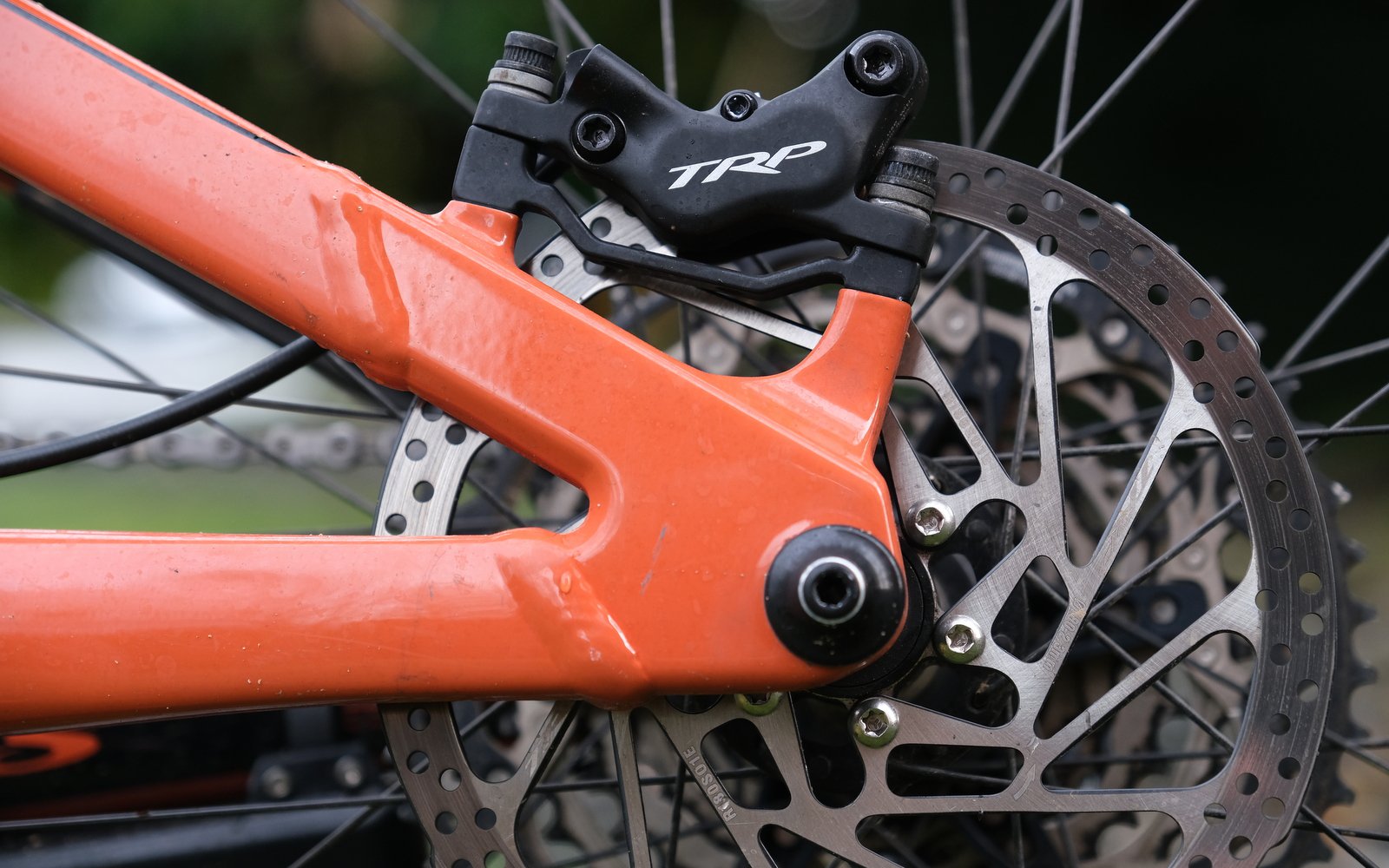
REVIEW
TRP Slate EVO Brakes Reviewed
Has there ever been a more fruitful sponsorship than TRP and Aaron Gwin? I can’t think of one that so thoroughly changed the perception of a brand, with TRP moving from a relative unknown to a serious contender in a very short period of time. For a guy that has experienced his fair share of sponsor-related drama over the years, Gwin really brought value to TRP.
Of course, if the product was crap, none of this would have meant anything. Some eyebrows would have been raised, a few curious fanboys would have taken the plunge, and then the scathing reviews would have halted any momentum. But the product is good! Both the Quadiem and the DH-R have a solid reputation and have kept TRP in the conversation.
But what about TRP’s lighter duty brakes? While not exactly “rare”, much less has been said about the Slate and the Trail compared to the DH-focused models. Having two bikes that could stand some brake upgrades felt like as good a reason as any to try to contribute to filling this void.
TRP Slate EVO
We’re going to start with the Slate EVO (Slate from here on in). The Slate is very closely related to the Trail models, but has a few differences in the name of cutting costs. The Slates are meant to be an SLX competitor, while the Trail is more in line with XT. Both use the same size master cylinder piston (10mm), the same size caliper pistons (16mm for all four), the same upgraded pad choices (all 4-piston TRP brakes use the same pad style, which also happen to be cross-compatible with Shimano XT and SLX 4-piston brakes), and the same changes to accommodate the thicker 2.3mm rotor (I had TRP send me a 180mm rotor for the rear and 203mm for the front, to match what I already had in place, but they also have 220 and 223mm options). They both run on mineral oil and they both use the same 5mm hydraulic hose. The upgrades that the Trail receives over the Slate are in the name of heat tolerance (a larger caliper reservoir, hybrid composite pistons vs the stainless of the Slate) and general fanciness. The result is a pair of brakes that will feel and perform similarly to one another in most situations, but with the Trail able to take on some heavier duty service due to improved heat management.
Both brakes are relatively simple, no frills affairs. Far from a complaint, each brake has what it needs and not much more. The levers are comfortable on your fingers. The reach adjustments are easy to use and effective. The clamp design is simple (honestly, getting rid of the finicky little Shimano pokey release thing is enough of a reason to upgrade in my books). The levers are fairly long, and avoid some of the preciousness of other lever designs out there. The calipers are straight forward. Everything seems to have a place and a reason and there are no extra adjustments that don’t do anything or fins and gizmos tacked on.
The Slates will run you 139.99 USD per wheel, plus $43-55 per 6-bolt rotor (size dependent, and tack on another 10 bucks or so for Centerlock) and $15.99 per adapter.

The Slate EVO lever assembly is really simple, without a lot of adjustments. The clamp is really basic and easy to use. I think other companies might be overthinking this.
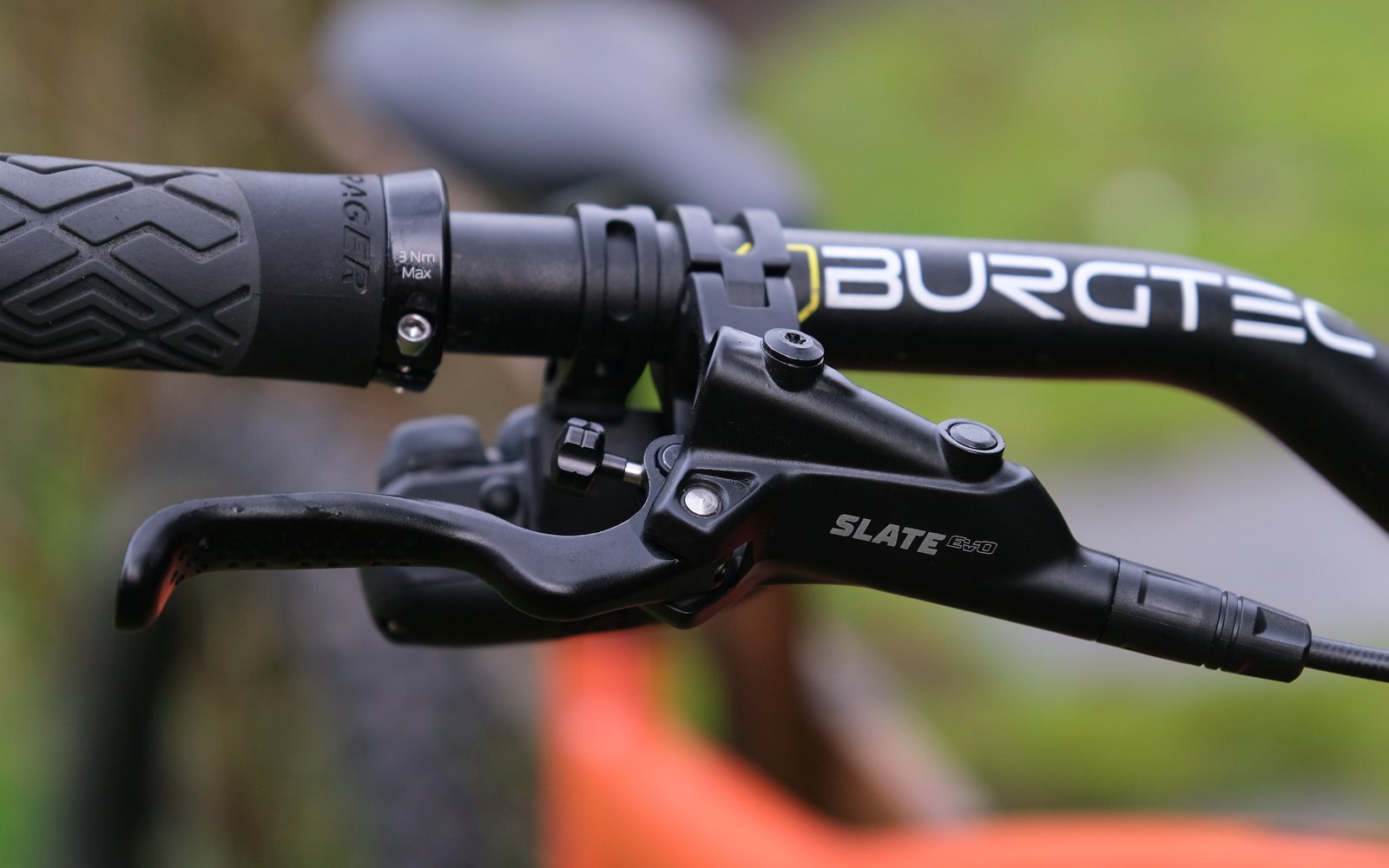
The lever itself is longish, with a fairly basic shape.

And one more lever shot.
Set Up
Remember when swapping your brakes was no big deal? On a modern bicycle, this task now sucks. Why are cable ports too small to allow for an intact brake cable/olive/nut to fit through? Allowing the thing that needs to go through the thing to fit through the thing feels like it should be a primary design consideration. Instead, we have to chop a cable in order to pull it out of a frame? Insanity! There has to be a better way to do this, and it may be on the brake companies to come up with a solution to a problem caused by frame manufacturers. Worse, the Ibis also required a bit of cordless drill surgery to remove a stripped bolt from one of the cable ports. None of this is the fault of TRP, or would have been different with any other brake, but I seldom pass up a chance to bitch about such things. This experience also has me rethinking my head-to-head comparison using the Canyon. I may just stick to messing with one bike.
TRP ships all of their brakes bled and plugged, with the hose attached at the caliper end. It should be as easy as threading the hose through your frame, mounting the levers and calipers, cutting your lines to fit and bolting it all together. If you do this properly, you should be able to avoid any sort of bleed. I made the mistake of not using gravity to my advantage. The proper course of action would be to remove the lever from your bike once you have your hose length sorted, and then take the plug out in such a way that the fluid stays in place. With the levers bolted to the handlebar a few cc’s of brake fluid came out, so a bleed was required. This took a few tries, between my Shimano funnel and the Tektro kit that TRP sent along. I’d probably count on having to do this yourself, as well.
With the brakes mounted, I moved on to installing the rotors, which beg to be noticed as soon as you pull them out of the package. While a bump up from 1.8mm to 2.3mm doesn’t sound like much, they feel significantly stouter than what we’ve become accustomed to, and make me question why nobody thought of this sooner. They feel like a rotor should and I’m left with an impression that they’re going to be with me for the long haul.
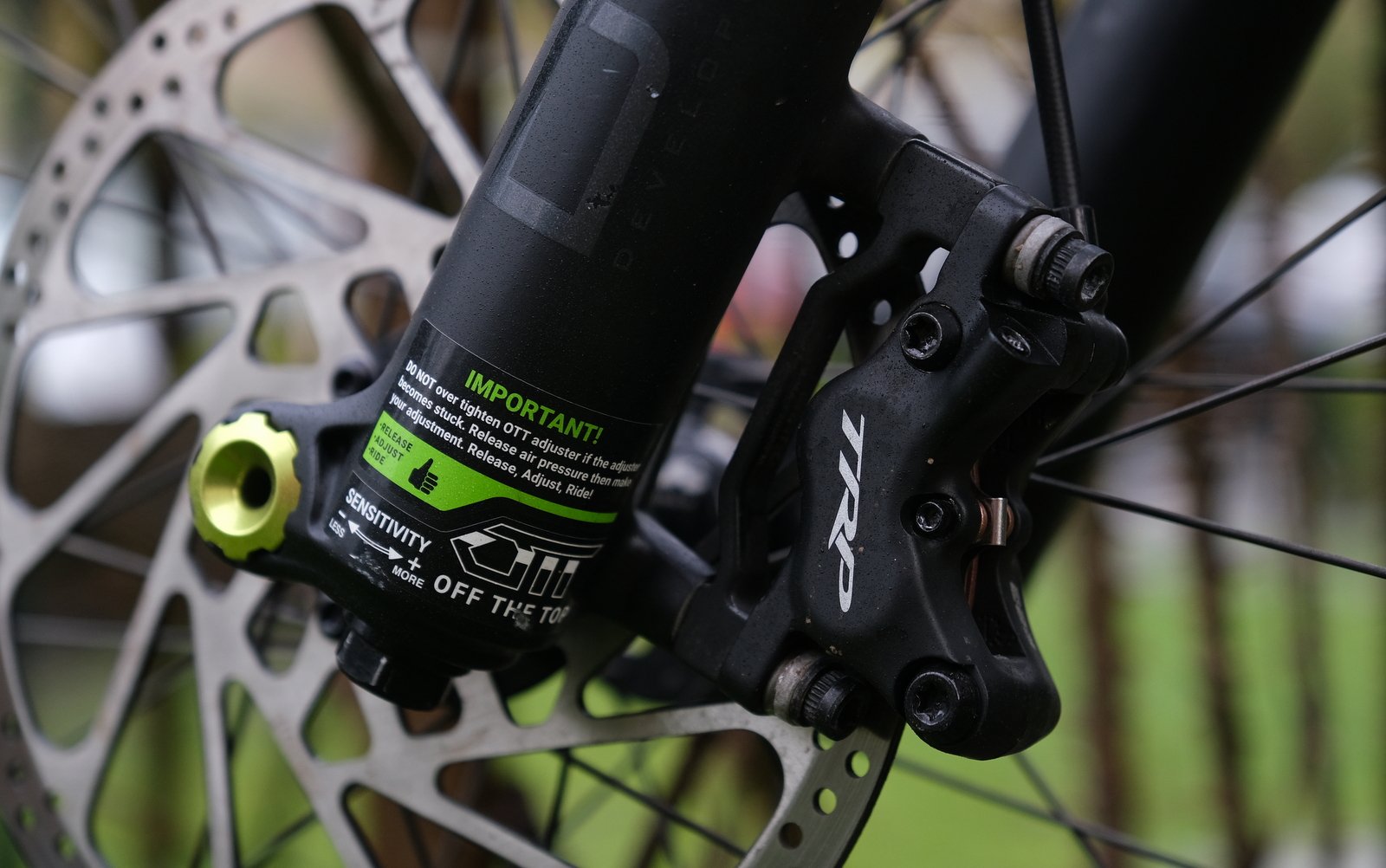
The rotor itself, while thicker, has a fairly predictable shape. As does the caliper.
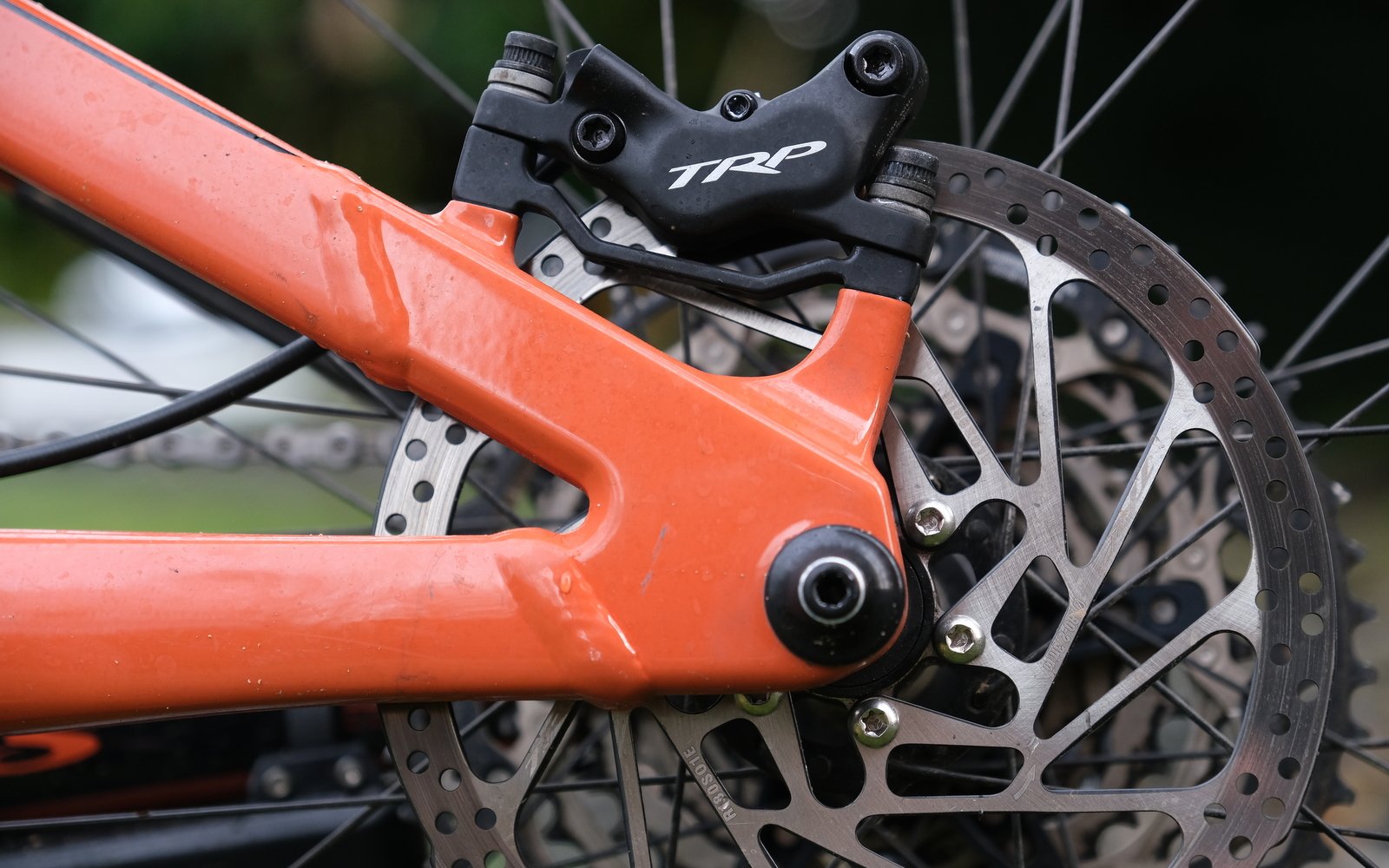
Another look at the rear caliper and rotor.
Another question that you might have is on shifter integration. TRP does offer your standard range of matchmaker and I-Spec shifter integration options, but I’m just rocking the straight up separate clamps here, so can’t comment on any of those other setups.
Rounding off our discussion about set up, we’ll touch on the sole adjustment available to the end user: the reach adjust dial on the inside of the lever. This dial is easy enough to manage, and it’s pretty trivial to get the levers to a point where they’re comfortable for your hand. There is no “free stroke” or “contact point” adjustment on this brake, so what you see is what you get. And what you get is a brake with incredibly short stroke. From max reach to fully locked up, the stroke is much less than the other brakes in my stable right now. It’s hard to put an exact number on this, as there are so many variables, but comparing the Slate to a Magura MT-5, the Slate had around 30mm of total stroke while the Magura had around 40mm (this was fairly unscientific, but I wanted to at least prove to myself that I wasn’t imagining things). With the Slates there is very little dead stroke so you’re very quickly in to functional braking. This is not something that I noticed while riding, but I did when I was standing around tugging on my brake levers.
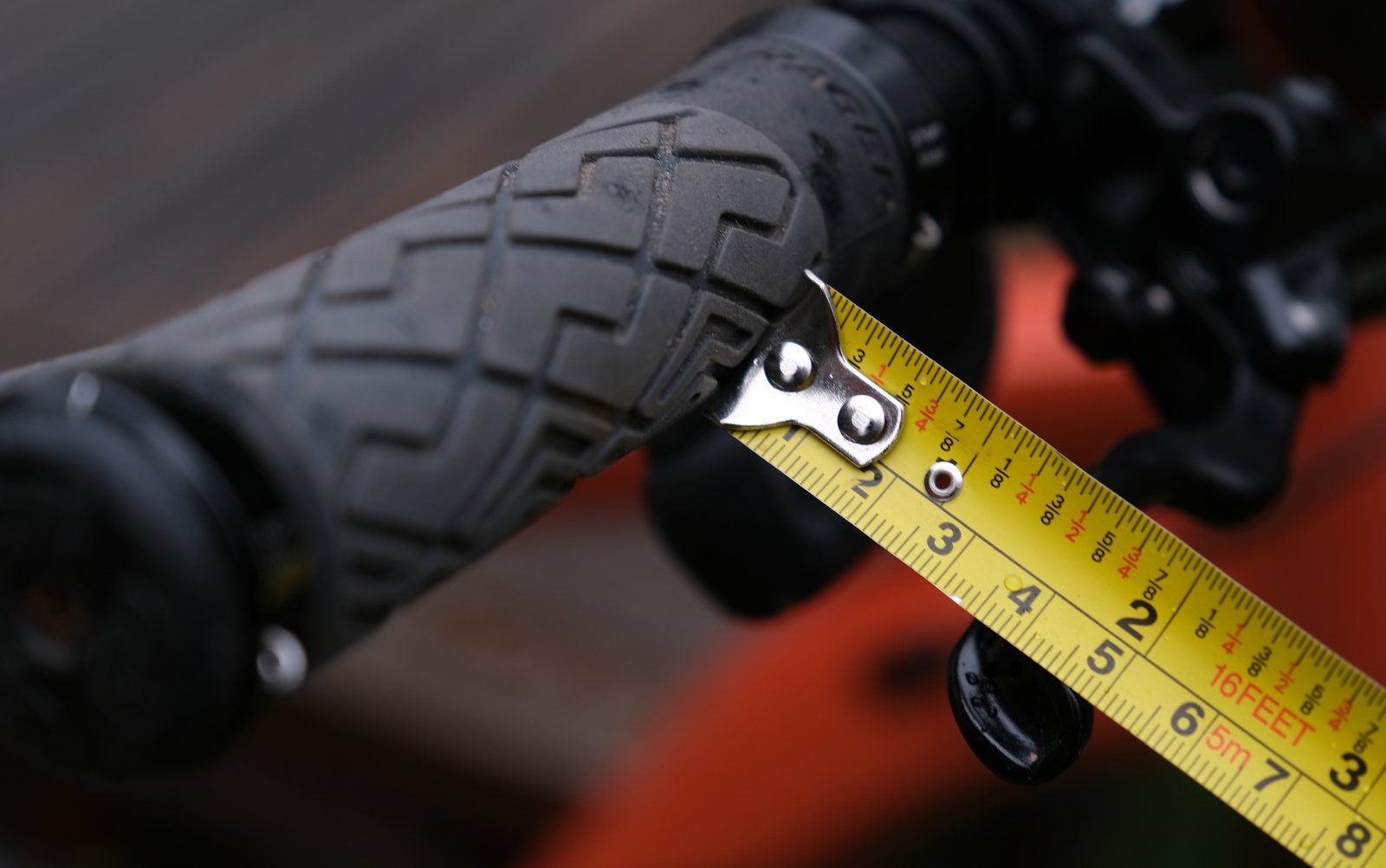
Yes, yes, yes. This isn't perfect. I'm measuring with a bloody tape measure and there's all kind of variables here, lever length and shape being the least of our concerns. But I measure 50mm (give or take) to the end of the lever here...
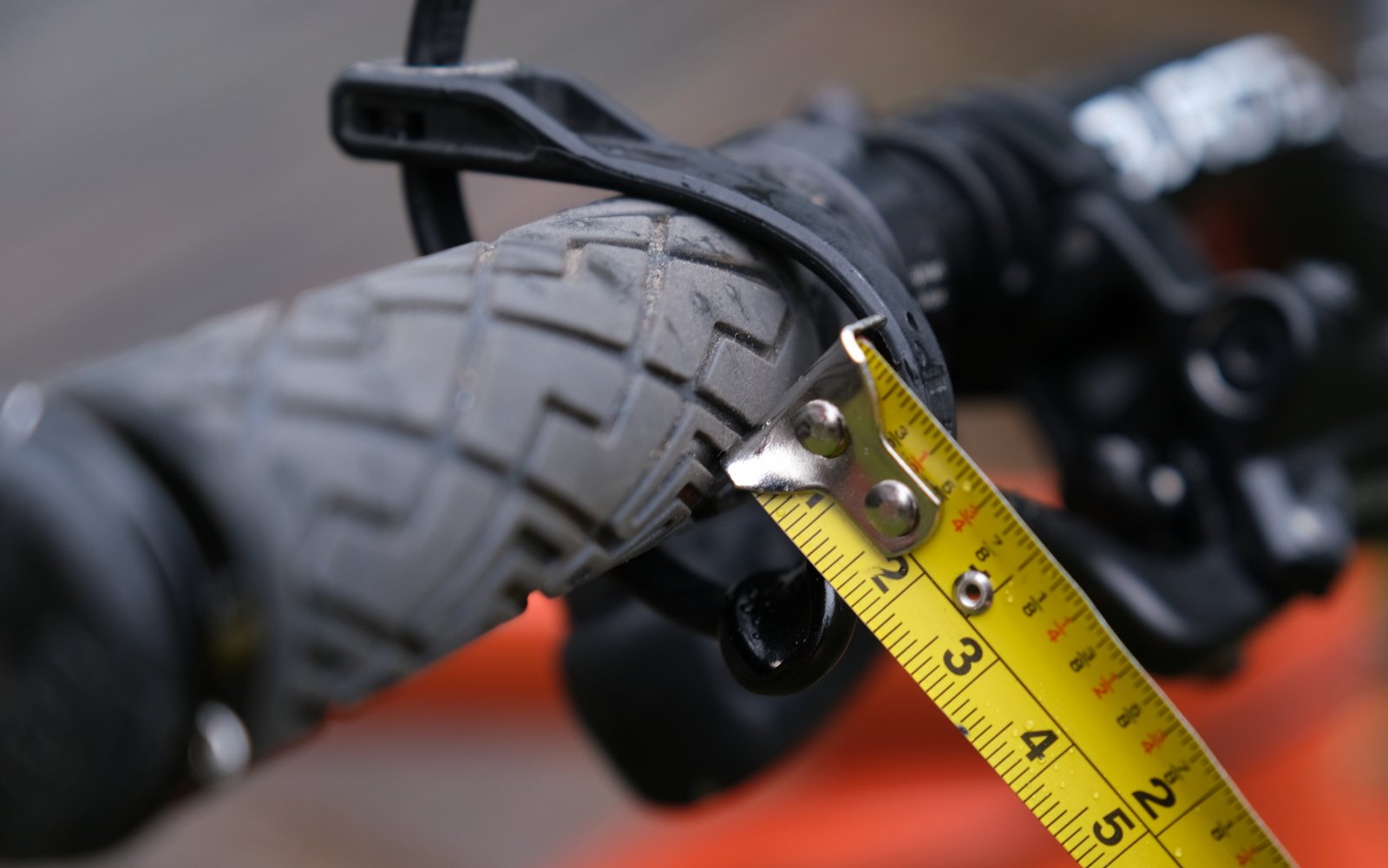
...and 20mm at full lock, for roughly 30mm of stroke. It's difficult to measure to the exact same point on the grip based on the geometry of how the lever pulls, so there is easily a few mm of error here.
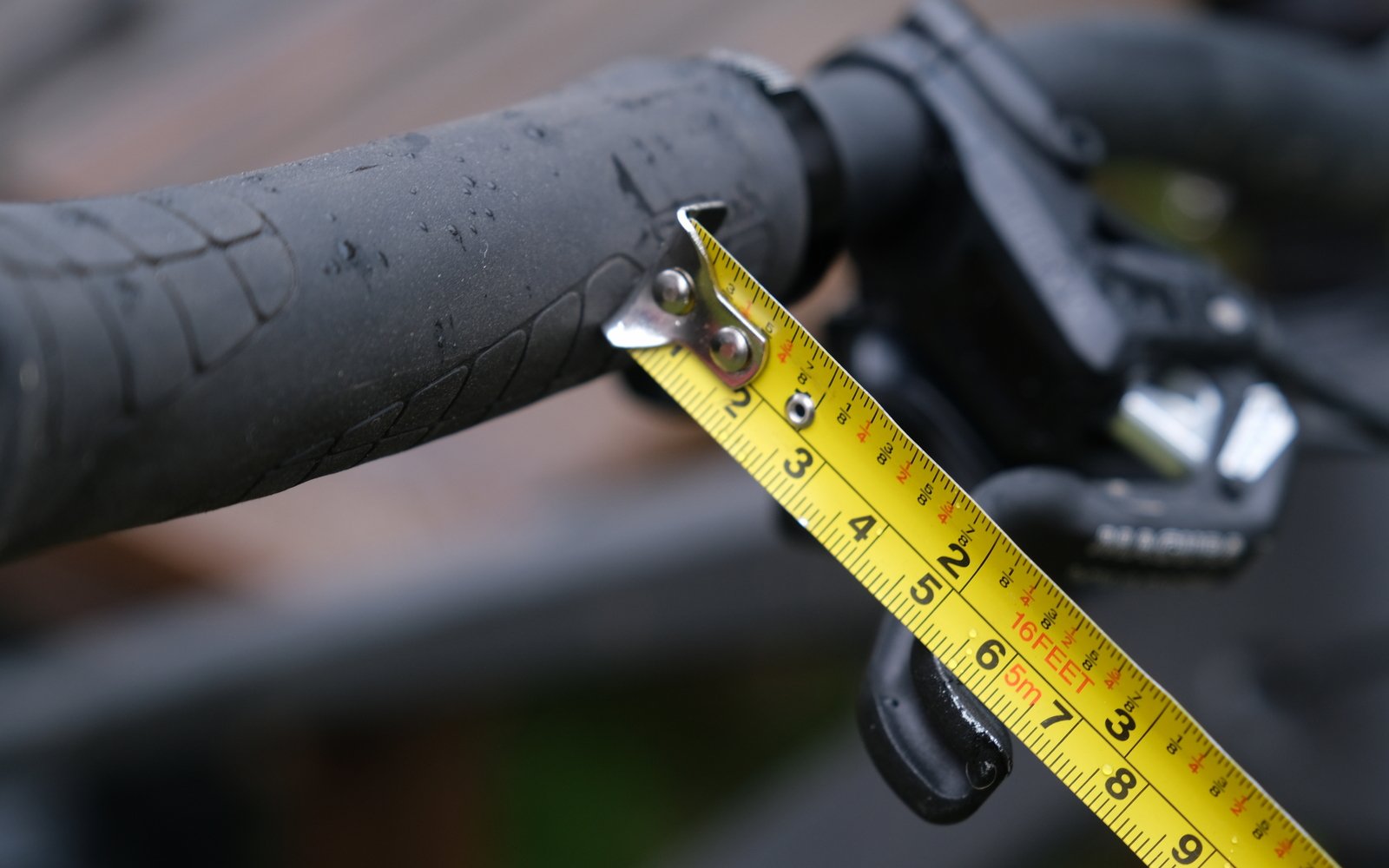
These Magura MT5s on the other hand are ~68mm to the end of the lever, and...
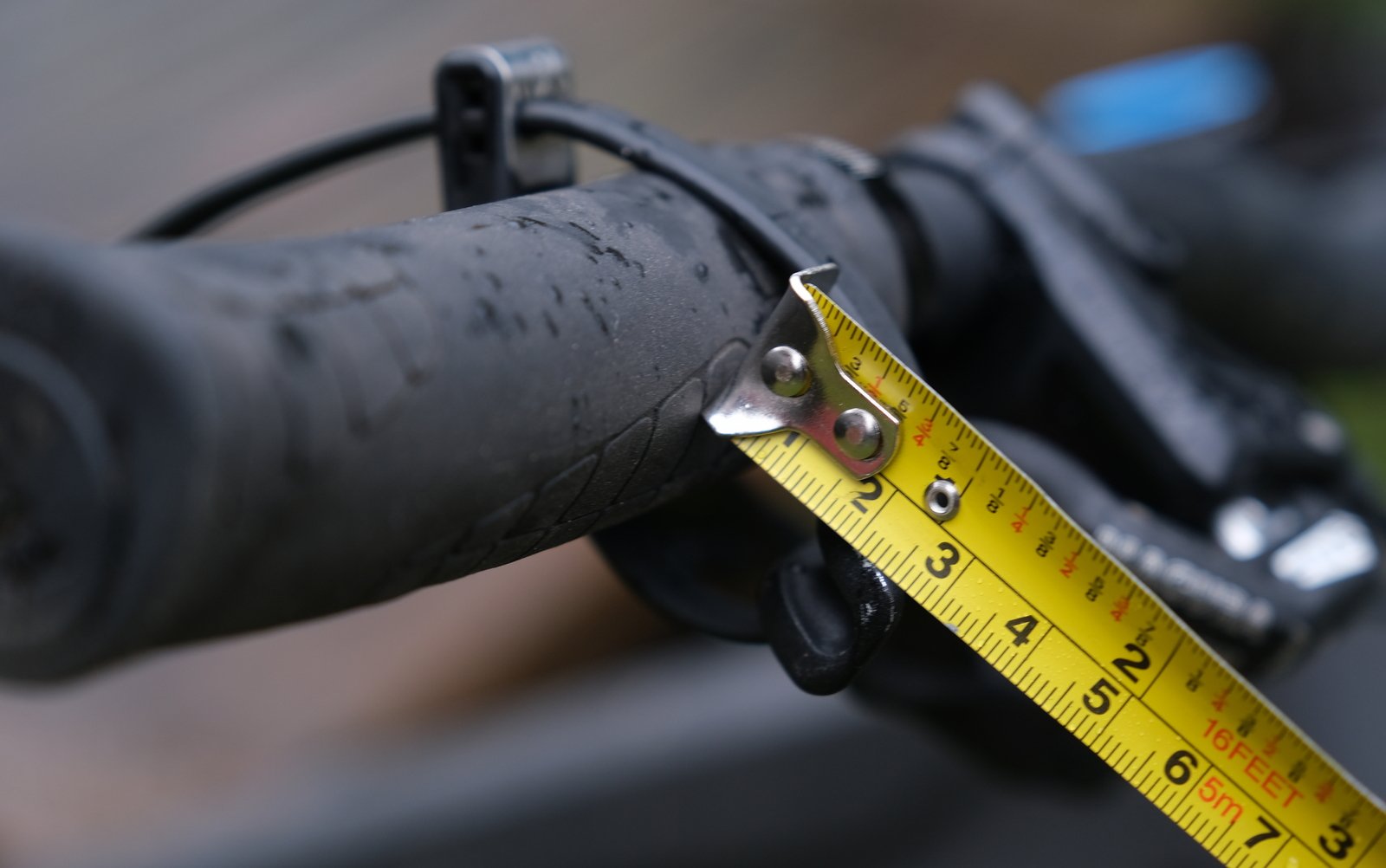
...28ish mm at lock up, for 40mm of stroke. Both would be at a similar distance when fully locked up and I think the 8mm distance is down to lever shape, with the Maguras having a more pronounced hook. It probably would have been better to measure where my fingers grip the lever, but I really just wanted to see if there was something to my observation and I'm pretty sure there is.
Performance
TRP included both the performance resin and sintered metallic pads for me to try, and they encouraged me to give the performance resin pads a shot before moving on to the metallic. To quote TRP directly:
The formula was developed directly with our UCI DH teams in the goal of making a pad that had a higher friction coefficient, a lower activation temperature and then to keep that friction consistent over a larger temperature gradient. Because of their unique resin formula, they don’t take a lot of temperature to activate the material, so they bed in very quickly, they offer the most amount of power off the first pull, and they actually last decently long in both dry and wet conditions.
From this perspective, TRP was successful. The brakes had a consistent amount of power whether it was your first pull at the top of the trail, or halfway down once your brakes had warmed up. They were super silent too. Outright power was okay, and significantly better than what I recently experienced with resin pads in an XT brake, which I thought were fairly lackluster brakes with resin pads installed. The Slates with resin pads are manageable, and could be a good choice for certain users looking for silence and consistency, or riding in areas that place less stress on brakes. At this point, the brakes felt “fine” to me, but I was looking for “great”. I decided to move on to the sintered pads.
This decision raised some questions, though. It feels like it’s very difficult to come to an agreement when having a conversation about resin vs. sintered pads. I’ve never experienced a resin pad that offered “more power” than sintered, but others claim the opposite. So, again I reached out to TRP for some more information and here is what they said:
Both resin and sintered pads will all have very similar friction coefficients once they reach their optimal temps. The difference is, resin will have a lower activation temp compared to sintered, and they will fall off faster than sintered. Saying one will have more friction than the other is really just a conditional statement depending on how much heat is flowing at any given time.
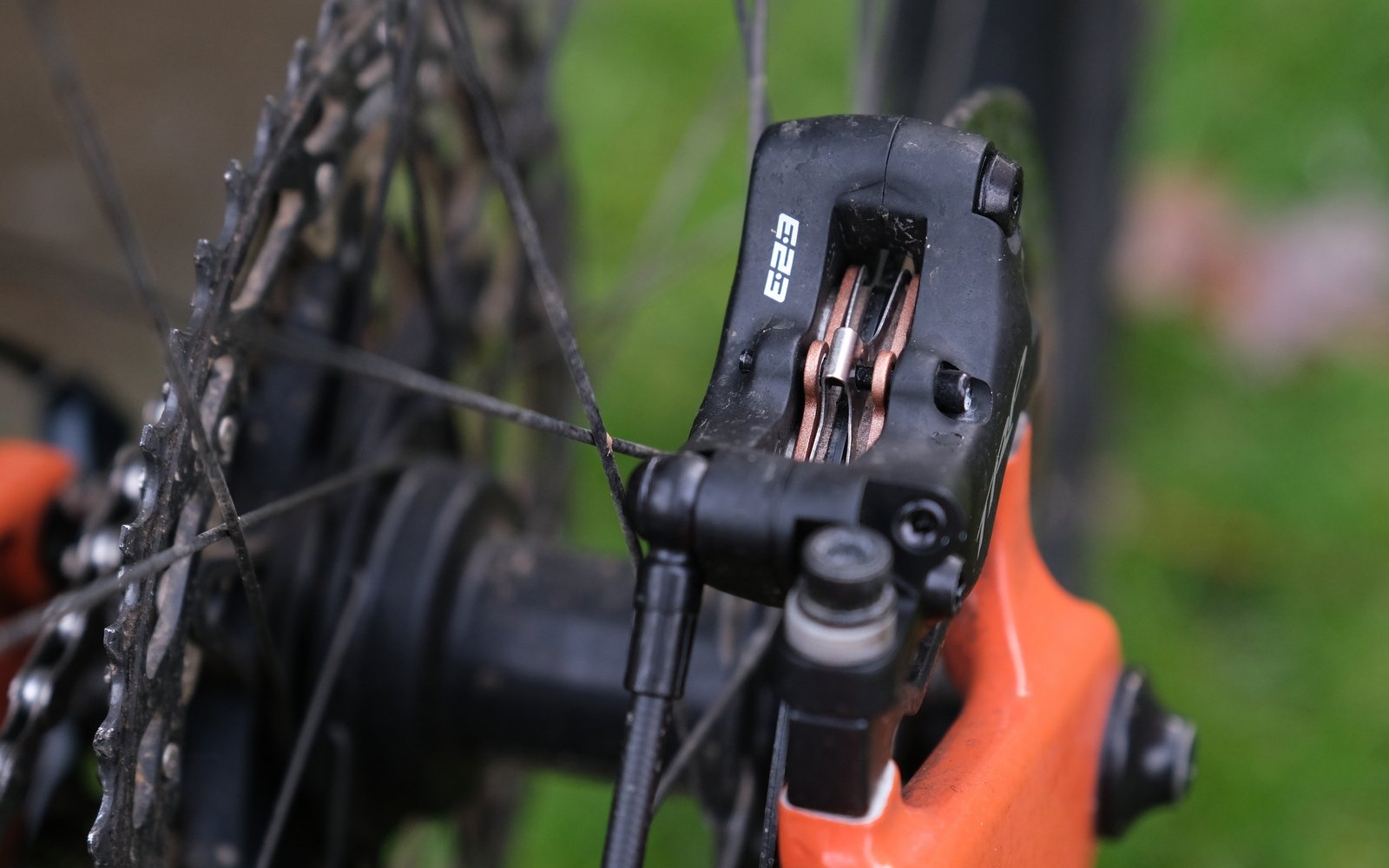
Top view of the caliper gives you a look at the metallic pads and the thicker rotors.
This offers some insight into why there might be such disagreement out there on pad material. It sounds like it’s possible that the pad that offers a particular user “the most power” could have a lot to do with how those pads are being used. For me, a not light guy who rides on steep terrain, sintered seems to be the answer. Perhaps your particular conditions could lead to the opposite conclusion. You’ll still be wrong, but at least we won’t have to argue about it now.
The good news for me is that moving to the metallic pads provided the increased braking performance that I was looking for. Yes, the metallic pads do require a bit more time to warm up (they’re not exactly quiet for the first few pulls in the wet) but this change turned these brakes into a contender.
Every mediocre bike rider out there has that one skill that they hang their hat on. For me, brake control is my thing. As a result, I’ve never been all that worried about modulation. Modulation, to me, is what you do with your fingers and complaining about “a lack of modulation” sounds to me like criticism of oneself.
These brakes may change my mind on that subject. I would say that they have a bit less outright power than an XT/SLX brake with metallic pads on an Ice-Tech rotor, but the power is more usable and consistent. It feels less like you’re riding a knife edge between maximum braking and locking up, and it’s easier to manage things at the extreme. The lever feel is very solid, without much flex or sponginess. It all results in nice, calm, predictable braking in any condition, dry or wet.
That’s not to say you should be throwing these things on your DH bike. The people around here who consider the Code to be an “all mountain” brake may be a little disappointed, but if that’s what you’re looking for, TRP has other brakes to compete in that segment. I would happily mount these brakes on any of the 150/160mm bikes in my possession, or on anything this side of a full on “Enduro” bike. I’m in no rush to re-mount the SLX brakes that I removed from the Ibis (which worked pretty well once I mated some Ice-Tech rotors with the stock metallic pads, but are a noticeable step behind with the crummy stock rotors). I love the thicker rotors, and while I haven’t tested their durability, they give me confidence that they will run true for the long haul. I love the simple lever and the basic clamp that doesn’t require you to juggle a separate piece (SRAM) or scream in frustration at a tiny little hole (Shimano). Most of all, I love the calm, predictable performance. These TRP Slate EVOs work well and they don’t cost a fortune (it does feel a bit crazy that 200 USD per wheel is considered “not a fortune”, but here we are) and what else do you really need?
Next Steps
What I haven’t done is use these brakes enough to comment on long term durability. I would estimate that I have something like 10-12 rides on the Slate EVOs. That’s 10-12 shoulder season/winter condition North Shore rides, so it’s not nothing, but I can’t pass judgment on their long term durability. Everything is ticking along well though. Pad wear seems fine and the thicker rotors are living up to their billing, but this hasn’t been a full season of use or anything like that. I am comfortable to speak about their general performance, though. My next step will be to get some time on the Trail EVOs, with the same pads and rotors, and perhaps come back to these at some point later in the season.
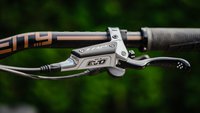
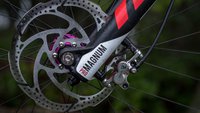
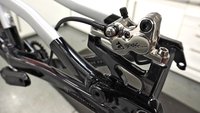






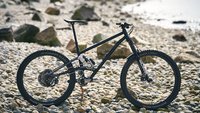
Comments
cheapondirt
3 years, 1 month ago
Great week for content here. Entertaining opinion pieces and then a review of an unglamorous product. I enjoy these ones a lot more than the more predictable reviews of top-end stuff.
Should I be defending the Codes on my 150mm bike? I feel the urge to, though it may reveal something about me as a rider. They just work well. I like how other brands make powerful brakes without having to go full DH, but I really like the RSC lever feel and SRAM's small parts availability, already had the bleed kit, and their lesser brakes are... lesser. It seems to me the Code RSC should be the brake of choice for almost anyone (in the SRAM ecosystem) who enjoys descending.
Reply
Garrett Thibault
3 years, 1 month ago
Here’s the defence: The sram guides had an issue with piston swell causing the levers to seize, shimano had a floating bite point issue, the first release of trp Quadiems lacked power, the Maguras has mixed reviews in lever durability, and Hayes had mixed reviews on quality control.
The Code was the only brake I was comfortable buying for a while. Once you’ve got them on more than one bike, it’s easy enough to make an argument to get them on the whole fleet. I even have codes on my dirt jumper at the moment.
Reply
Dave Tolnai
3 years, 1 month ago
No judgement meant on the Code's. Just pointing out that if that is how you roll, these probably won't be a replacement.
Reply
Tjaard Breeuwer
3 years, 1 month ago
Yep, I thought that came through clearly, and was a good way of putting it.
Especially as the Codes are so widespread, it seemed like a good way to place these brakes,
Reply
Pete Roggeman
3 years, 1 month ago
Codes are popular and highly thought of for good reason. I've had several sets of the latest gen across multiple bikes and they've all been great for me. Same story for just about everyone I've ridden with in that time.
But also great to have options. Bikes are Boeing if they all look the same and have the same stuff on them.
Reply
Vik Banerjee
3 years, 1 month ago
Ha! I have Codes on a 140mm bike and feel no shame. They didn't fall readily to hand due to distributor issues or I'd have them on my hardtail which rocks 0mm rear travel.
Reply
Justin White
3 years, 1 month ago
Agree. Brakes shouldn't be solely influenced by travel or "bike category" or bullshit like that. They should be influenced by rider preference, intended use, and maybe rider weight ;-). If I intended to rip even an "XC" bike down long steep stuff at silly speeds, you'd better believe I'm using something more than a 2-piston with 140 rotors and organic pads, that might come on a bike like that, to haul my 100kgs to a stop. Partly because I'd melt those little brakes right quick, partly because I just like really f-ing strong brakes that I can control/modulate "right here" (flexes index finger)
Reply
Mammal
3 years, 1 month ago
Yep, for sure. I have 4-piston brakes on my DH (200mm), trail squish (200/180), and hard tail (180/180).
Reply
JT
3 years, 1 month ago
"Perhaps your particular conditions could lead to the opposite conclusion. You’ll still be wrong, but at least we won’t have to argue about it now."
B e a u t. Gonna have to use this one at the next engineering meeting.
Possibly one of the best things Tektro/TRP did was design for use with Shimano pads. That right there insured they would be welcome in most any shop. The bleed is simple/Shimano enough as well.
Reply
Mammal
3 years, 1 month ago
On TRP brakes - I'm glad they have a short free-stroke, I find that's beneficial when there's only a reach adjustment. My TRP Quadiems on my DH bike have massive levers made for gorillas and a huge amount of free-stroke, so you don't really have any choice but to run them way out there. They're great working brakes, but man, does it take some getting used to when my other 2 bikes run Shimanos with tiny levers placed exactly where I want them.
On the Ripmo AF - Seeing as you seem to be keeping that for a test ride, you should give the Cascade Link a try. I found it really transformed mine into the bike I was always looking for. It really helped with some of the beginning to mid-travel leverage curve issues you pointed out in your review.
Reply
cornedbeef
3 years, 1 month ago
I run the Deore 4 pot brakes on my road bike with the TRP performance resin and semi metallic pads. The TRP resin has a more gradual initial bite which I prefer over the Shimano resin pad. The semi-metallic is also quite powerful and quiet.
I've also been on a streak with contaminating pads in rainy commutes- resulting in two sets of Shimano pads and one set of TRP performance resin pads written off. They all are contaminated beyond saving (all my tricks as a professional mechanic did not work).
I'll likely go with TRP resins when I wear mine out; and cross my fingers they'll come back in stock.
Reply
Pete Roggeman
3 years, 1 month ago
Interesting. Do you think your commute route has a section with a particularly oily or dirty patch of road or something? What a bummer to go through so many pads like that.
Reply
Mammal
3 years, 1 month ago
I can see that happening for sure.
I get that from time to time, just with the mountain bike on the tray rack of my vehicle. I drive around 35km through town before stopping for an after-work ride, and especially if the roads are a bit wet out, the pads can end up pretty shyte afterward.
Reply
JVP
3 years, 1 month ago
You could try a little spray bottle with water and just a few drops of baby shampoo or dish detergent. A few squirts of that on the rotors before riding is amazing if you've done a grimy drive. I saw this tip from a World Cup mechanic video a few years ago, and holy hell it works well.
Reply
Justin White
3 years, 1 month ago
I would say be careful with the baby shampoo, some have glycerin in them, basically vegetable oil! Not much, but trading road grime for even a little glycerin might not be the best option.
Reply
Pete Roggeman
3 years, 1 month ago
Thanks to both of you. I'll try some mild dish soap. Have got a few sets of rotors that took a beating on the back of the car this winter.
Mammal
3 years, 1 month ago
Thanks, I'll definitely try that! And thanks JW for the glycerin warning.
Reply
cornedbeef
3 years, 1 month ago
I think it's the rainy season and all the rainwater being mixed with the shit, piss, and oil that's on the ground on certain sections of my commute. The shit and piss is a secondary thing, as I don't think urea or fecal matter will contaminate pads.
Reply
Dave Tolnai
3 years, 1 month ago
Your commute doesn't sound like a lot of fun.
Reply
Dave Smith
3 years, 1 month ago
Everyone else: let's endlessly debate brake technologies!!!!
Me: I wish there was a way to standardize the product photography
Reply
Dave Tolnai
3 years, 1 month ago
I look forward to a long and detailed e-mail where you tell me everything that I did wrong.
Reply
Dave Smith
3 years, 1 month ago
Ha. There will be no email. Your work was fine.
It was always a wish of mine when I was on staff to give the reviews and gear features a branded look. It continues to be a wish of mine in the post-NSMB world but would require coordination that would be impossible with the current decentralized office model.
Reply
UFO
3 years, 1 month ago
Your riding impressions sound very similar to a set of their early Slate T4 brakes that I was really happy with. They just felt like they had so much control between say 20-80%, and max power from 80-100% was on par with my tried and true Shimanos.
They were so good I bought another set, but one end of this set was a total let down, and the other end was better but not as impressive as my original set. I swapped in some known good pads first with no improvement. Then I swapped levers from my first set and once again no dice. The new levers and pads mated to the old calipers and lines worked well, so by deduction the issue was in the new lines/calipers. All the pistons seemed to move and retract fine, but by the then I had no motivation to troubleshoot down to whether it was the lines or calipers that were the culprit.
The only thing the shop had to offer was "well these are entry level brakes and there's a reason they are cheaper than Shimano's 4 pots". So needless to say I'm back to Shimano's for all of our household bikes, and I haven't shopped at that shop anymore.
Reply
Dave Tolnai
3 years, 1 month ago
Glad to hear you had one good experience. Bummed to hear about the bad one. For such a simple thing, brakes can be a finicky beast, can't they? It's a bummer that your shop wasn't much help. Might be worth a call/e-mail in to TRP. Both are available here in the warranty section of the FAQ.
Reply
UFO
3 years, 1 month ago
Thanks for the help, though this happened a number of years ago when TRP were first breaking into the market. I'm not one to beg and plead, I'll vote with where I bring my business instead.
Sounds like you're off to a great start with your set so I hope they've sorted out their QC issues
Reply
Timer
3 years, 1 month ago
Another difference I noticed between resin and sintered pads, at least with Sram: The power of sintered pads doesn't fall of as much in the wet. Which is a bit surprising, considering that warming up the brakes is harder I the wet.
Reply
Dan Lees
3 years, 1 month ago
This is interesting...
The Calipers and, to a slightly lesser extent, Levers look unsurprisingly incredibly similar to the set of Tektro Orion 4 Pots I have in a box as emergency spare brakes that I bought for £25 per end (including adaptors and pads!) at the beginning of the great component shortage of 2020-202X.
I have never had to use them and reviews are a few and far between, though they get good reviews when spec'd on the Marin Alpine Trail.
Might give them a whirl at some point!
Reply
Dave Tolnai
3 years, 1 month ago
I have some pretty cheap Shimano brakes on both of my commuters. One set works really good (once I swapped the pads and rotors from the resin/resin only garbage) and the other is pretty weak. I wouldn't choose to run the better set on a mountain bike, but they would probably work just fine in a pinch. Point is, it's tough to figure out the performance of these things just based on price or manufacturer. You might have some solid, low cost gems on your hands. Or you might not.
I'll try to remember to explore the Tektro/TRP relationship a bit for the review of the Trails. It would be interesting to try to find out a bit more about what is shared, what isn't, and how it all works.
Reply
sjc115
3 years, 1 month ago
Dave, I would love to hear your thoughts on how they compare to the MT5's.
Reply
Dave Tolnai
3 years, 1 month ago
I'll have some words involving the MT5 in the nearish future.
Reply
TristanC
3 years, 1 month ago
I've been using Tektro Gemini HD-M520s that came stock on my bike for almost 3 years now - the same parent company. I was worried I'd have to swap them immediately, but have nothing but good impressions from them; I haven't bled them once and they just keep working.
Reply
Ripbro
3 years, 1 month ago
Anyone tried running a 2.3 mm rotor in a set of code rsc brakes? I need a new rotor and if I can run a thicker rotor, it will have better heat management and will last longer from purely a wear perspective.
I have heard people running 2.0 mm Magura mdr-c rotors on codes, but wondering if 2.3 is possible.
Like you mentioned, why didn’t someone think of thicker rotors sooner? Rattling finned pads came first? I guess there is a weight penalty, but I’m running a steel nx cassette (3rd season on it) so I don’t care.
Reply
Cooper Quinn
3 years, 1 month ago
The new(ish) Sram HS2 rotor is also thicker, and definitely compatible with your Codes.
Reply
Cr4w
3 years, 1 month ago
If you're going upgrade from the standard Avid Centerline rotors (1.85mm) to the new Avid HS2 rotors (2.0 mm) I'm thinking I may as well go to the TRP R1 (2.3mm). If we're splitting hairs I want it all: 220mm rotors front and rear and max rotor thickness.
Reply
Ripbro
3 years, 1 month ago
That’s why I’m wondering if anyone has tried the 2.3 on codes. I’m not sure why it wouldn’t work if you used the thicker rotor for the initial setup
Reply
Cooper Quinn
3 years, 1 month ago
I'd be curious if you chucked a 1.8mm or 2.0mm rotor in there, as the thicker rotor could be part of the cause behind the short free stroke?
Reply
Mammal
3 years, 1 month ago
Probably. I also think this is the reason behind my TRP Quadiems having a massive amount of free-stroke, even though they are older brakes. I bet they were made to accommodate both regular and fat discs.
Reply
YDiv
3 years, 1 month ago
Does rotor width play a role in free stroke? My assumption was that it doesn't, if the pad clearance remains the same.
Thicker rotors might give shorter free stroke at the very beginning, but as the pads wear and pistons extend, I'm fairly certain that the pull is largely dependent on how much elasticity the square seals were engineered to have.
Reply
Cooper Quinn
3 years, 1 month ago
This would also be my guess (as it aligns with my understanding of "how brakes work"), but... yeah. Is that how it plays out in the real world? I dunno!
Reply
Dave Tolnai
3 years, 1 month ago
I didn't try this, but I think it would be the same as compensating for 0.5mm of pad wear. I guess it wouldn't be that hard to squeeze one a few times on a thinner rotor and see what happens.
Reply
Justin White
3 years, 1 month ago
They 180 and 220, but not 200mm? That's... dumb.
Reply
Ripbro
3 years, 1 month ago
Pretty sure you can get 180, 203, 220 and 223 2.3 mm, but maybe not all in center lock
Reply
Justin White
3 years, 1 month ago
Yes, still no 200, even in 6-bolt. Which means I would need silly washers to use these brakes with their >180 rotors with the existing adapter on my fork.
They even have both 23mm and 17mm PostMount adapters alongside a 20mm one, and that's almost sillier than rotors available in "140mm, 160mm, 180mm, and 203mm". To quote Sesame Street: "One of these things is not like the others!" This is one thing SRAM does right, nice even 20mm jumps.
Reply
Pete Roggeman
3 years, 1 month ago
Follow the link and it'll show all four sizes available.
Reply
Justin White
3 years, 1 month ago
203 yes, but not 200. Sometime 20mm jumps, sometimes 23mm, 17mm, one is just 3mm difference. They even do adapters that would work with 200mm rotors, but still no 200mm rotors! That's weird.
Reply
Justin White
3 years, 1 month ago
"and there are no extra adjustments that don’t do anything or fins and gizmos tacked on."
I get what you're saying: these brake are simple and no-frills; but really, which brakes have which adjustments that actually don't do anything?
And Shimano's Freestroke does not fit into this category: it does do something, just that many people don't know how to adjust it; even though it works just just Hope's adjustments and pretty much no one tries to claim those don't work or are difficult to adjust.
Reply
Dave Tolnai
3 years, 1 month ago
Fair point. Perhaps I've just succumbed to the anti Shimano freestroke propaganda, or maybe I'm just projecting my insecurities onto these brakes? I never bother with freestroke on most brakes, and just use reach adjust to set the distance from the bar at the end of stroke. That's the only thing that I'm particular about, and I don't really care where the levers start.
Reply
Justin White
3 years, 1 month ago
The big ol' hook on the end of that lever looks awesome, probably not gonna slip off the lever no matter how much throw you dial in.
But I never liked the Shimano-style inboard hump that seems to imply they left room for two or three fingers. Just make a relatively straight shot from the pivot to the hook, add to that no-frills look and gotta be simpler to make.
Reply
Justin White
3 years, 1 month ago
"and they actually last decently long in both dry and wet conditions."
Long-term testing will be interesting. "decently long" is likely quite different for a UCI team compared to the average rider: they're probably going to toast them quicker, but most of us normies have a tighter budget.
I do have to admit, after using SRAM's Power pads for a while in fairly wet New England, that modern resin/organic pads definitely seem better than they used to be, though they're still not at the same wear level as a good sintered metal or ceramic: MTX Red FTW! Quiter than SRAM metal, lasts at least as long, and Strong!
Reply
Justin White
3 years, 1 month ago
And their friction answer is incomplete. We've known for a while that resin pads' operating window is lower down the temp scale (they grab colder but also overheat colder), but the missing part of the question is if the windows are the same size. In other words, resins come up to temp faster allowing max friction earlier, but does the friction fall off happen at a high enough temp to allow the same total amount of braking? In the past, except for a light rider on flattish terrain, the resin operating window has been way too small, with the added deficit that when the max temp is exceeded, the pads break down or glaze pretty rapidly. Maybe they resolved this, but that answer doesn't seem to imply such.
Reply
Pete Roggeman
3 years, 1 month ago
Those are good questions.
Reply
Justin White
3 years, 1 month ago
"the power is more usable and consistent" and "the lever feel is very solid, without much flex or sponginess"
This is what I came here hoping to see. Shortish throw, with good modulation provided through lever force instead of lever displacement, that's what I like.
Too bad I just ordered Guide RSC levers in an attempt to min-max my brakes on a budget. After 2.5 years, I decided the stock Guide R's have the worst combo of mushy _and_ long throw, especially coming off Hope Tech 3 E4's. But can't/shouldn't afford a full new set of brakes since the Guide R's do "work". Hopefully the SwingLink and Contact adjust means I can dial in a shorter throw and gain a bit of power (for the same lever force) at the same time do get closer to my ideal. If not, these brakes, with metal pads, are now on my shortlist.
Reply
cheapondirt
3 years, 1 month ago
Based on my experience going from Code R to RSC, you should find what you're looking for with the new levers. I had the same complaints and they were resolved. I get the impression SRAM designs calipers with a lot of pad rollback for clearance, then bandaids that with swinglink. Cheaper levers obviously get the swinglink removed, but the calipers are unchanged, so the resulting system is shitty by design.
As for the contact point adjuster, I just set them to the shortest throw possible and haven't touched the dials since. If you disregard SRAM's recommended bleed procedure, you can use them to get an overbleed. YMMV on that.
Reply
Mark
3 years, 1 month ago
Great, no-nonsense review that provides the right info that most riders need. Nicely done Mr T
Reply
Jonathan Fournier
3 years, 1 month ago
Thanks for the review, solid write-up as usual :)
I have been soul searching in the brakes department since receiving the new Knolly Chilcotin last fall.
Previous bike had code R, which felt pretty good compared to previous 2015 XTs.
The Chili came with 2021 XTs. Wandering bite point after 5-6 rides. What a drag!
I considered getting some RSC, but decided DOT was comitting an environnemental crime.
Finally ended up getting some Formula Cura 4. For now I can say they look pretty rad, but I was not able to test them more then bedding them in the street. Hopefully I can find the feel of the code with the oil of the Shimano..!
Maybe I should had considered the gravity TRPs. But hey, bike parts choices.. whats a first world problem do we have..!
Reply
DBone57
2 years, 2 months ago
I just got a brand new F/R set delivered to my door (SoCal USA) from Merlin Cycles for $112 USD... Wow! Can you answer a couple of questions so I'm ready when they get here. 1) Does the standard Shimano bleed funnel fit? I also have a Park Tool BKM-1 kit as well with several different adapters if you know the thread pitch on the lever reservoir. 2) How was the pad rotor clearance in terms of rub... good like Shimano/SRAM or tight like Magura? 3) Can you confirm that standard (non finned) Shimano 4 piston pads fit? Thanks for the great review and I just couldn't pass up such a great deal.
Reply
Martin
2 years, 2 months ago
This comment has been removed.
Please log in to leave a comment.